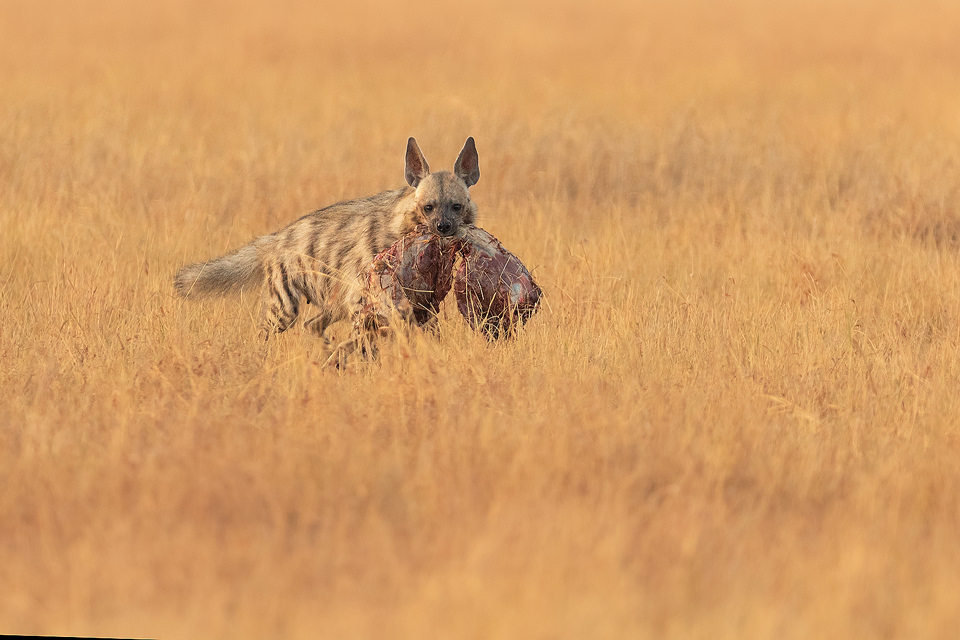Striped Hyena with scavenged kill
Striped Hyena with scavenged kill. A female striped hyena with a scavenged blackbuck antelope carcass. Blackbuck National Park, Gujarat, India.
This image was taken during one of the most memorable mornings of wildlife photography I have had in India so far.
As the sun rose over the grassland we spotted this female striped hyena dragging a large blackbuck carcass back to her den. The commotion and scent of blood had attracted the attention of a wolf who waited nearby, not wanting conflict with the larger and more powerful hyena.
After a long struggle the hyena eventually opted to tear up the carcass and carry it back in smaller chunks. The wolf continued tracking her closely. Suddenly out of nowhere a young antelope panicked and split from the herd right next to us! An intense chase followed, with the wolf eventually catching the blackbuck. He then carried it right past us, allowing some fantastic head on portraits.
Seeing the action unfold out of nowhere and so close to us was something I’ll never forget. Experiences like these are why I love wildlife photography so much. You never know what’s going to happen!
Striped Hyena with scavenged kill – About the Striped Hyena:
The striped hyena (Hyaena hyaena) is a species of hyena native to North and East Africa, the Middle East, the Caucasus, Central Asia and the Indian subcontinent. It is listed by the IUCN as near-threatened, as the global population is estimated to be under 10,000 mature individuals.
Striped Hyenas are light brown in colour with black stripes on their flanks and legs. Like other Hyena species they have a downward sloping backs, this is due to their hinds legs being shorter and heavier than their front legs. a pointed muzzle and pointed ears. Their distinctive pointed ears are perfect for radiating heat which helps to keep their temperature low int he hot desert climates they inhabit. When threatened they often erect mane that extends down the centre of their backs, making them appear much larger and more intimidating. Each of their paws has four non-retractable blunt claws.
Striped Hyenas typically inhabit hot and dry areas including deserts, semi deserts, scrubland, woodlands, grasslands and rocky terrain. Family groups live in dens; typically caves or burrows with narrow entrances concealed by dense vegetation or large boulders.
Striped Hyenas are nocturnal omnivores and unlike their spotted cousins, forage either alone or in pairs. Their diet consists of mammals, birds, reptiles, insects and fruits. Although they sometimes hunt opportunistically they are primarily scavengers, feeding on carrion and other animals kills. They use their incredibly powerful jaws to gnaw and crush bones. Hyenas are capable of digesting parts of prey other animals cannot thanks to their incredibly strong stomach acid. This makes them important members of the food chain as they help to clean up rotting carcasses reducing the spread of disease.
Striped Hyena Conservation:
Striped Hyena are listed as near-threatened by the IUCN, with the global population estimated to be under 10,000 mature individuals. The population is under threat from deliberate and incidental persecution along with habitat loss, fragmented populations and decreasing prey base. They are often hunted or poisoned throughout their range, and although it has a fairly large population, it is scattered over a wide area and often isolated from other populations.
You can find more about Hyenas here
